Create AI Generated Album Covers Your Fans Will Love
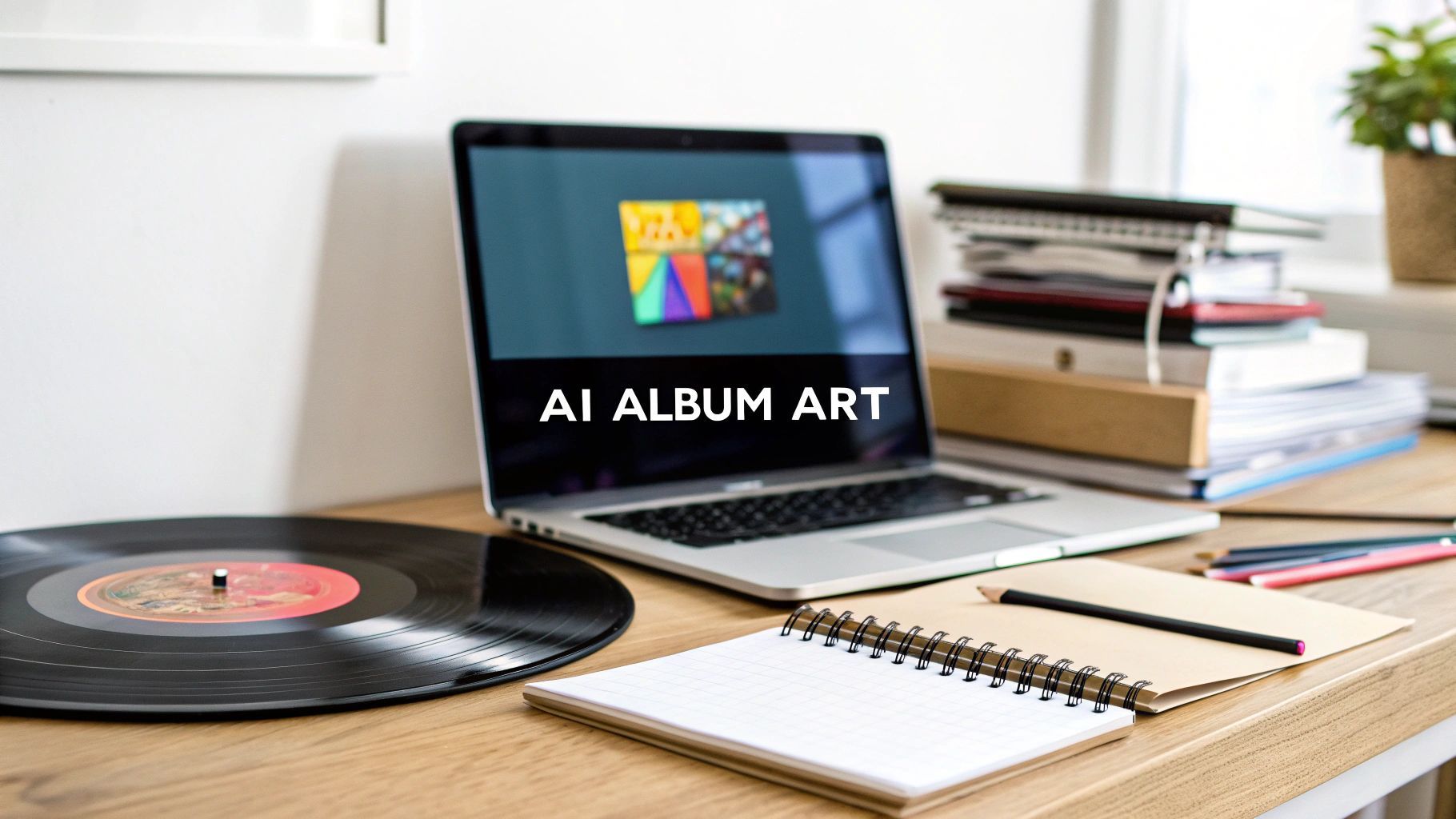


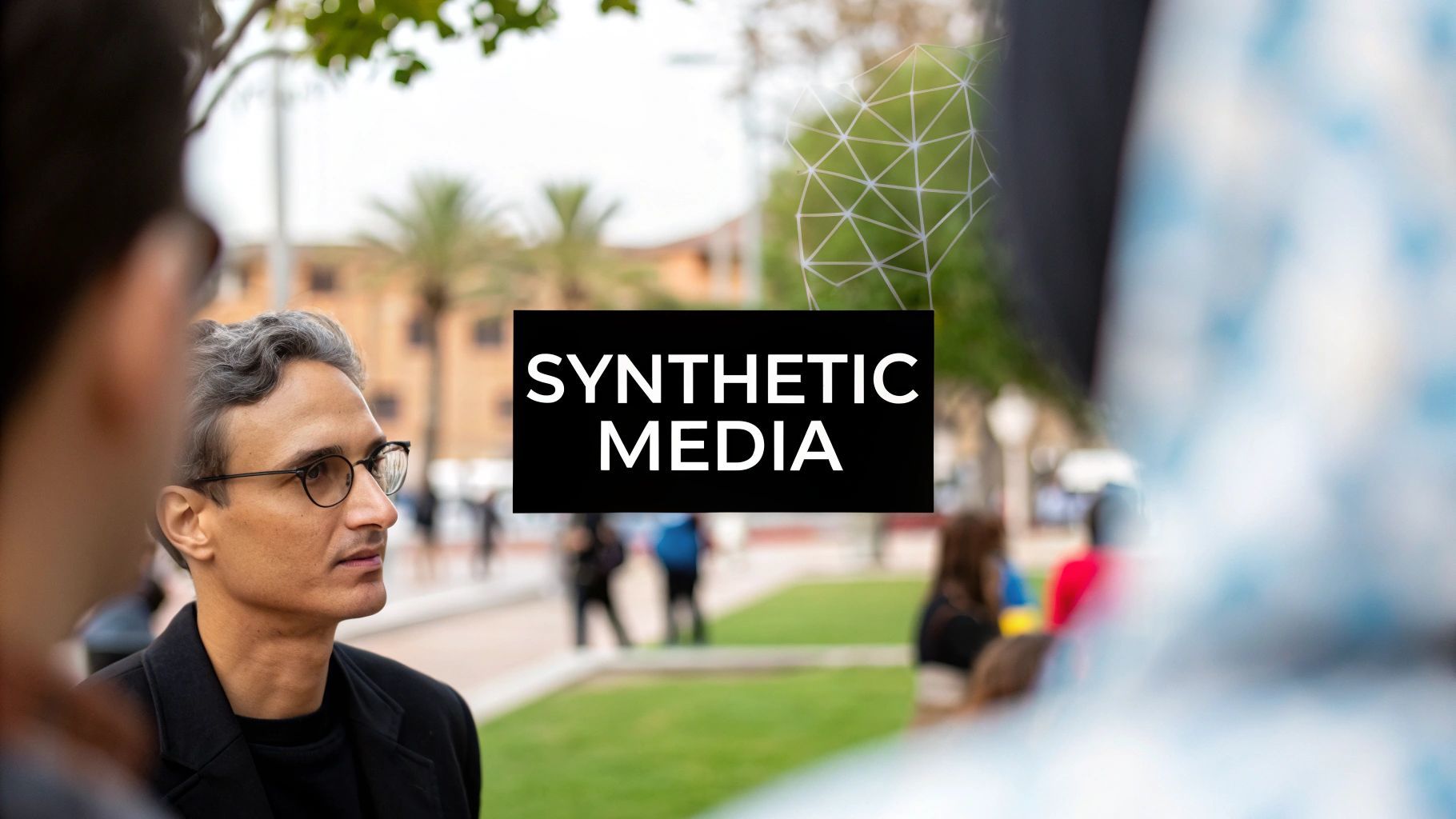
What is synthetic media? This guide breaks down AI-generated content with real-world examples, explaining how it works and what the future holds.
So, what's all the buzz about synthetic media?
Put simply, it's any media—we're talking images, videos, sound, or even text—that's been cooked up or heavily modified by artificial intelligence. Imagine an AI as a digital artist, a virtual actor, or an automated storyteller, capable of spinning up brand-new realities from just a few words.
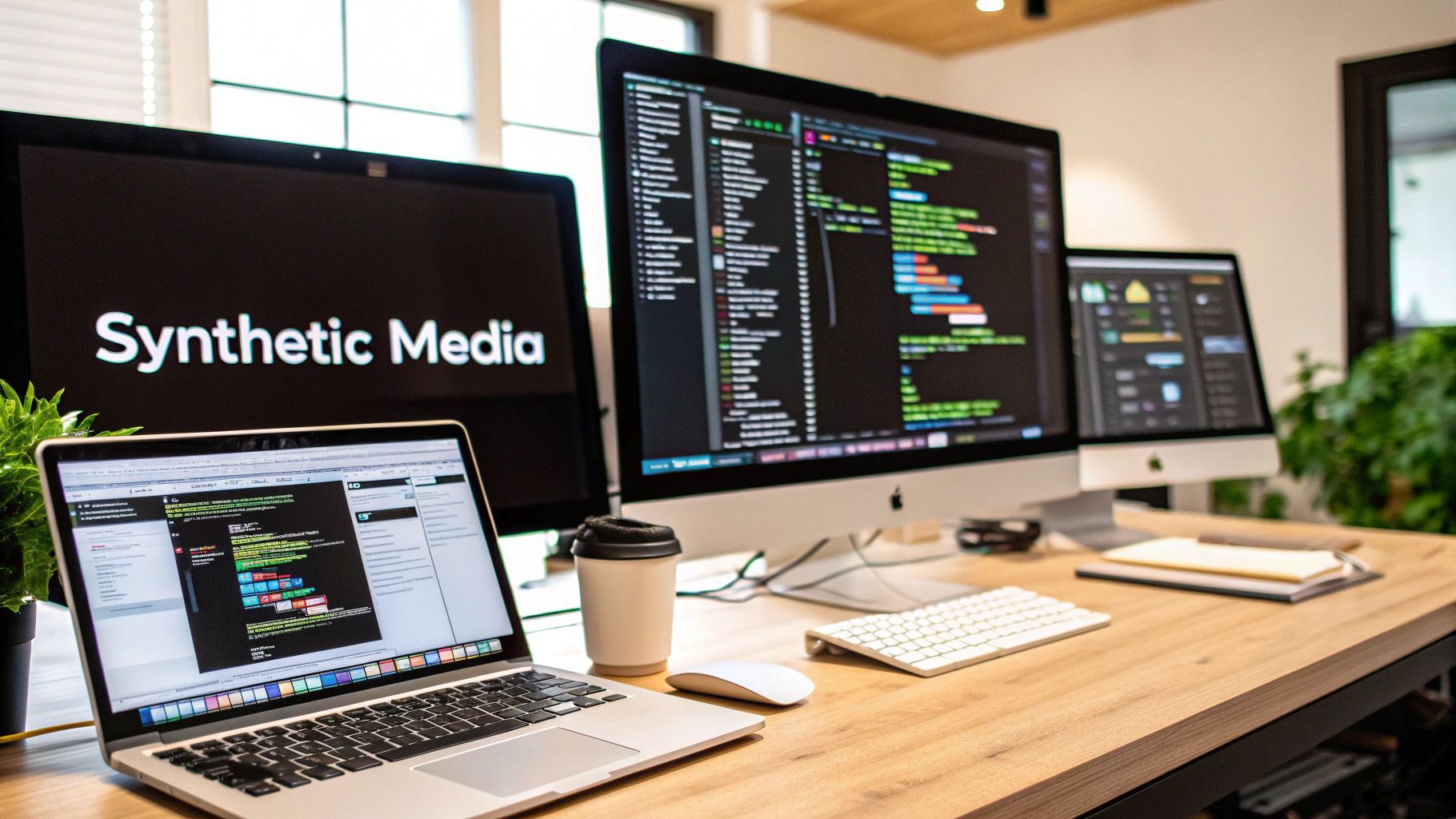
Picture a world where you could whip up a movie trailer without hiring a single actor, produce a podcast in a language you don't even speak, or conjure photorealistic images of places that exist only in your imagination. That's not a scene from a sci-fi flick; it's the here-and-now, all thanks to synthetic media.
At its heart, this tech relies on some seriously sophisticated algorithms—usually deep learning models—to churn out content so convincing it's often impossible to tell it apart from the real deal.
How does it work? It all starts with training. To teach an AI to create a human face, you'd feed it millions of photographs. It meticulously studies every last detail—light, shadow, skin texture, you name it—until it can generate entirely new faces from scratch. The very same idea applies to composing music, writing articles, or even cloning your voice from a few seconds of audio.
Synthetic media isn't just one thing. It's a massive umbrella covering a whole spectrum of AI-generated content, each with its own tricks and tools. To get a handle on it all, it helps to know about related concepts like what is voice writing, which digs into how our spoken words get turned into text—a cornerstone for many audio-based AI tools.
To help you get the lay of the land, here’s a quick rundown of the main types you'll bump into.
This table breaks down the primary categories of AI-generated content, giving you a snapshot of what they are and where you've likely already seen them in action.
| Media Type | What It Is | Common Example |
|---|---|---|
| Synthetic Images | Still images dreamed up by an AI, often from a simple text prompt. | A photorealistic portrait of a person who doesn't actually exist. |
| Synthetic Video | Video footage created or tweaked by AI, including the infamous "deepfakes." | A video of a historical figure appearing to deliver a modern speech. |
| Synthetic Audio | AI-generated voices, music, or sound effects that sound just like the real thing. | A podcast narrated by the cloned voice of a famous celebrity. |
| Synthetic Text | Any written content, from articles to code, generated by a language model. | An email or blog post written automatically by an AI like ChatGPT. |
Getting a grip on these categories is your first step to understanding just how much synthetic media can do. From shaking up entertainment and marketing to transforming education and accessibility, its impact is already massive—and it's growing faster than ever. This guide will walk you through how it all works, where it's making waves, and the big ethical questions we need to talk about.
Ever stared at an AI-generated image of a person who doesn't exist and wondered, "How did a computer even do that?" Or maybe you've heard an AI-composed song that genuinely slaps. It feels like magic, but the reality is a fascinating—and surprisingly intuitive—process of digital trial and error. AI models basically learn to create the same way we do: by studying the greats and then practicing, a lot.
At the heart of most image and video generation is a brilliant concept called a Generative Adversarial Network, or GAN. The easiest way to think of a GAN is as a duo of dueling AIs: one is an art forger (the Artist), and the other is a sharp-eyed detective (the Critic).
The Artist's whole mission is to create fakes. It starts out terrible, maybe producing a pixelated blob that’s supposed to be a cat. The Critic, who has been shown thousands of real cat photos, takes one look and says, "Nope. That's garbage. Not a cat." This back-and-forth happens millions of times. With every round, the Artist gets a little better at its forgery, and the Critic gets a little smarter at spotting fakes.
This digital cat-and-mouse game continues until the Artist's creations are so good that the Critic is fooled about half the time. At that point, the Artist has basically graduated. It has learned the very essence of "cat-ness" and can now generate brand new, utterly convincing cat photos on command.
Of course, this whole process needs fuel. The AI doesn't just invent things from a void; it needs a massive library of examples to learn from. You feed it a ton of input data—pictures, text, audio clips—and it chews through all of it to pick up on the patterns, styles, and subtle rules.
This simple flow shows you the basic journey from raw data to a finished piece of synthetic media.
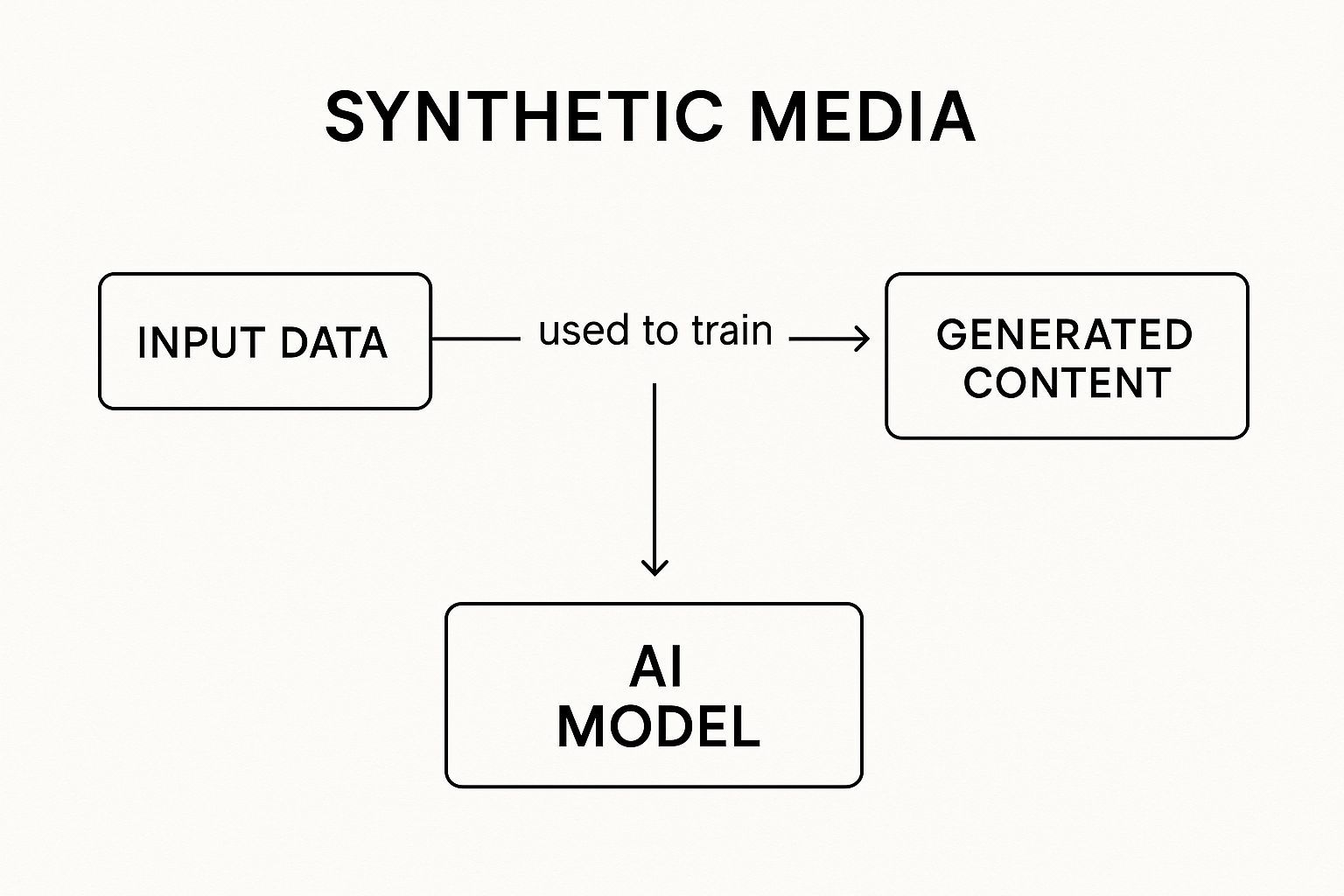
It's a classic "garbage in, garbage out" situation. The better and more diverse the data you feed the AI, the more convincing and creative its final output will be.
While GANs are the rock stars of the visual world, different AI models handle other creative jobs. When it comes to generating text—like the kind that powers ChatGPT—the MVP is the Transformer model.
Transformers are absolute wizards at understanding context. They don't just see words; they see the relationships between words in a sentence. This allows them to predict what word should come next, letting them string together coherent paragraphs, write surprisingly decent poetry, or even spit out functional code. They're the literary brains of the synthetic media world.
For sound, you have specialized models like neural vocoders and WaveNets. These are trained on endless hours of audio, learning the tiny inflections of human speech or the complex harmonics of a cello. This is how you get everything from hyper-realistic AI voiceovers to entirely new musical scores. If you're curious about the music side of things, our guide on how to make AI-generated music really gets into the nitty-gritty.
And this isn't just some niche academic pursuit. This technology is a big deal. The synthetic media market was valued at USD 5.06 billion and is expected to explode to USD 21.70 billion by 2033. That’s a staggering growth rate of 18.10% per year, showing just how deeply these tools are becoming part of our world.
At the end of the day, it all comes down to pattern recognition on a massive scale. By analyzing millions of examples, these models build an intuitive "feel" for what makes a face look like a face, a sentence sound natural, or a melody catchy. It’s like a digital apprenticeship, but one that happens at a speed and scale we humans can only dream of.
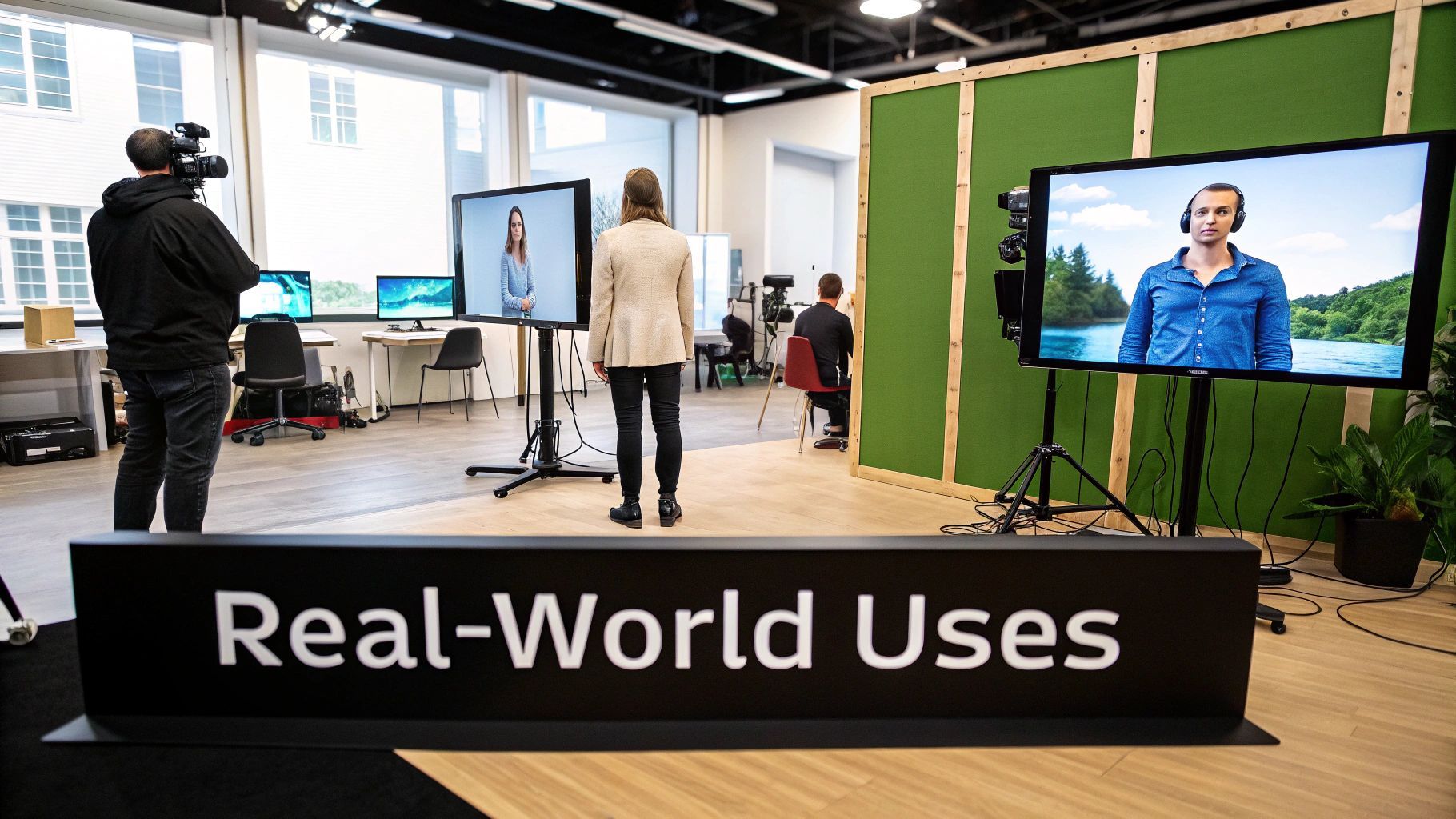
If you think synthetic media is just some sci-fi concept cooking in a lab, think again. It’s already out in the wild, changing the way we make movies, sell products, and even learn new skills. This isn't a "what if" technology; it's the engine behind some of today's most creative and compelling content.
From Hollywood soundstages to your social media feed, AI-generated content is becoming a core part of the creator's toolkit. It’s democratizing high-end production and giving artists the power to do things that were flat-out impossible just a few years back.
The entertainment world was an early adopter of synthetic media, and the results have been nothing short of spectacular. Remember seeing a young Harrison Ford crack his whip again in Indiana Jones? Or when actors who have passed away are brought back for one last, emotional scene? That’s the magic of AI at work.
But it’s not just about flashy, big-budget effects. This tech is rippling across the entire media landscape:
Indie Film Power-Up: Filmmakers can now create breathtaking virtual sets or complex visual effects without needing a studio's blank check. Seamless Global Dubbing: AI can recreate an actor's voice in another language while perfectly syncing their lip movements, making international releases feel way more natural. The 24/7 News Desk: Some outlets are even experimenting with AI news anchors to deliver round-the-clock updates without a human ever getting tired.
Digital artists are also having a field day with these tools. If you’re curious how they pull it off, we actually have a whole guide on how to create AI art that walks you through the entire process.
In advertising, getting someone's attention is half the battle. Synthetic media is giving brands a whole new arsenal to create campaigns that are personalized, engaging, and scalable. Forget one-size-fits-all ads; we're talking about crafting a unique experience for every single viewer.
The most famous example? Virtual influencers. These are AI-generated personalities, like the famous Lil Miquela, who have millions of followers and ink deals with major brands. They offer complete creative control and can promote a product from anywhere in the world—real or imagined.
For a brand, this is the ultimate dream: a spokesperson who is always on-brand, never gets tired, and can be anywhere in the world at a moment's notice.
Beyond digital celebrities, companies are using AI to create thousands of ad variations on the fly. They can test different images, headlines, and voices to see what clicks with specific demographics, making their campaigns smarter and more effective. For a deeper dive, check out this great resource on AI applications in digital marketing to see how businesses are putting these ideas into practice.
It’s no surprise that the gaming industry feels like a natural home for synthetic media. AI is breathing new life into virtual worlds by creating non-player characters (NPCs) who can hold genuinely dynamic, unscripted conversations. It's also being used to procedurally generate massive, unique landscapes, so no two adventures are ever identical.
The worlds of education and training are also getting a major upgrade. Just imagine the possibilities:
Surgeons in Training: Medical students can practice high-stakes procedures on hyper-realistic synthetic patients, where a mistake is a learning opportunity, not a disaster. Conflict Resolution Practice: Customer service reps can role-play with AI avatars that simulate angry or confused customers, building their empathy and problem-solving skills in a safe space. The Ultimate Language Partner: Learners can chat with an AI tutor that adjusts its vocabulary and speaking pace to their level, offering endless, patient conversation practice.
These examples make it clear that synthetic media is far more than just a cool party trick. It's a genuinely useful tool that's solving tough problems, cutting costs, and opening up a whole new world of creative and practical possibilities.

Like any genuinely powerful tool, synthetic media is a double-edged sword. One side promises a creative explosion, making it easier than ever for artists and businesses to bring their wildest ideas to life. The other side, however, casts a long and complicated shadow, raising serious questions about trust, truth, and identity in our digital world.
Understanding both sides is key to navigating this new terrain. It's not about being scared of the technology but about respecting its power and using it wisely. Let’s weigh the incredible opportunities against the undeniable risks.
The good news first. Synthetic media is a massive democratizing force for creativity. What once required a Hollywood budget and a small army of specialists can now be pulled off by a solo creator with a decent laptop.
This opens up a world of possibilities.
Slash Production Costs: Need to shoot a commercial in Paris? Forget flying a whole crew out. You can now generate a perfect digital backdrop, saving thousands in the process. Supercharge Workflows: Marketing teams can instantly dream up dozens of ad variations, each tailored to a different audience, without organizing a single new photoshoot. Unlock New Art Forms: Artists can blend realities, create impossible visuals, and push the boundaries of storytelling in ways we're only just beginning to imagine.
For musicians, this stuff is a total game-changer. It can help compose melodies, generate unique instrumental tracks, or even create entire promotional music videos from a simple text prompt. In fact, a whole new generation of AI tools for musicians is popping up to handle the technical heavy lifting, freeing them up to focus on what they do best: create.
Now for the flip side. The very realism that makes synthetic media so compelling is also what makes it so dangerous in the wrong hands. The word "deepfake" didn't enter our vocabulary by accident—it’s the catch-all for AI-generated content designed to deceive.
The ethical minefield here is complex and seems to grow bigger every day. As the U.S. Department of Homeland Security wisely notes, the danger isn't just the tech itself, but our own "natural inclination to believe what we see."
As AI-generated content becomes indistinguishable from human-created material, it creates a dual threat. First, it can be weaponized to spread misinformation. Second, public awareness of this may erode trust in all digital information, regardless of authenticity.
This slow erosion of trust has serious consequences. Deepfake fraud reportedly doubled from 2022 to the first quarter of 2023, yet a shocking number of people are still completely unaware of the threat.
The risks are everywhere:
Spreading Misinformation: Imagine a fake video of a world leader declaring war. Or a CEO falsely announcing their company's bankruptcy. The power to manipulate public opinion and tank markets is terrifying. Identity Theft and Fraud: Scammers are already using AI-cloned voices to impersonate panicked family members or company executives authorizing fraudulent wire transfers. In one jaw-dropping case, criminals used synthetic audio to trick a manager into wiring $35 million. Reputation Damage: It’s frighteningly easy for a malicious actor to create defamatory content to ruin a personal or professional reputation. By the time it’s proven fake, the damage is already done.
It's clear that with great creative power comes the potential for great harm. The challenge lies in figuring out how to embrace the good while defending against the bad.
To put it plainly, every amazing application of synthetic media seems to have a shadowy counterpart. This table breaks down that fundamental tension between the incredible potential and the very real risks we're facing.
| Potential Benefit | Associated Ethical Risk |
|---|---|
| Democratizing Creativity: Allows anyone to create high-quality content without a big budget or technical team. | Widespread Misinformation: Makes it easy for bad actors to generate convincing fake news, videos, and audio at scale. |
| Personalized Entertainment: AI can generate custom movies, music, or game characters tailored to individual tastes. | Non-Consensual Content: Creation of explicit or defamatory deepfakes to harass or blackmail individuals. |
| Efficient Business Operations: Automates content creation for marketing, training, and customer service. | Sophisticated Fraud & Scams: AI-cloned voices and faces are used for identity theft and to authorize fraudulent transactions. |
| Advancements in Art & Science: Enables new forms of artistic expression and powerful simulations for research. | Erosion of Public Trust: As people become aware of fakes, they may start to distrust all digital media, including authentic information. |
This isn't a simple case of "good versus evil." The same technology fuels both sides of the coin, which is what makes navigating this new world so tricky.
So, how do we fight back? It's a constant cat-and-mouse game. As the AI models that generate this content get better, so too must the tools designed to spot their handiwork. The good news is that a multi-front defense is taking shape, focused on technology, policy, and good old-fashioned education.
Key Strategies for Building Trust:
Advanced Detection Tools: Researchers are developing sophisticated AI models that can spot the subtle digital "fingerprints" left behind during the generation process. Some of these models are already hitting over 83% accuracy on benchmark datasets. Digital Watermarking: Think of this as embedding an invisible, permanent signature into AI-generated content. This "digital provenance" would let platforms and users instantly verify where a file came from. Clear Labeling and Regulation: Tech giants and governments are slowly but surely moving toward policies that require clear, unmissable labels on AI-generated content. This simple transparency helps everyone know when they're looking at something made by a machine.
Ultimately, the path forward requires a delicate balance. We have to keep exploring the incredible creative avenues that synthetic media opens up while simultaneously building the guardrails needed to protect ourselves from its misuse. Fostering an informed, critical eye is our best defense in a world where reality is becoming increasingly negotiable.
So, where is all this headed? If what we have now is impressive, the future of synthetic media is shaping up to be absolutely wild. The tech is quickly moving past just spitting out static images or pre-baked videos. We're charging headfirst into a world of real-time, interactive, and deeply personal digital experiences.
This isn't just about making cooler content for less money. It’s about completely rewiring how we engage with the digital world. Think of the jump from old-school flip-book animations to modern CGI—we're on the brink of another leap just like that, where AI-generated content becomes a seamless, living part of our daily lives.
One of the most mind-blowing frontiers is real-time generation. Imagine hopping into a video game where the background characters don't just loop the same three lines of dialogue. Instead, they have unique, unscripted conversations with you, remembering what you said last time and reacting to your choices with an actual personality. That’s the future of immersive entertainment, right there.
This same technology will bring virtual worlds and the metaverse to life, filling them with AI-driven characters that make these digital spaces feel truly inhabited. Customer service is getting a facelift, too. Picture virtual assistants that not only talk to you but show you solutions in real-time through a photorealistic avatar. It's a massive step toward making our chats with tech feel way more human.
The next big shake-up is hyper-personalization. Forget ads that are just "targeted" because you browsed for shoes once. I'm talking about a movie trailer where the main character looks and sounds exactly like you, or an educational video that adapts its examples and teaching style on the fly to match how you learn best.
This level of customization is going to touch everything:
Marketing: Brands will create ads that are individually crafted for every single person who sees them, sending engagement through the roof. Entertainment: Your streaming service could offer up movies with alternate endings generated just for you, based on the kinds of stories you love. Education: A history lesson could let you ask a synthetic Abraham Lincoln your specific questions, and he’d answer in a way that clicks for you.
When we look at the future of AI-generated content, it helps to see how it fits in with what’s already out there. For instance, understanding UGC video gives you a baseline for how AI is set to both complement and totally disrupt the traditional creator economy. This personalization engine will make digital content feel less like a one-way broadcast and more like a two-way conversation.
This futuristic vision isn't just a fun "what if"—it's backed by some serious economic momentum. The synthetic media market isn’t some niche trend; it’s a major economic force that’s here to stay.
The sheer scale of investment and adoption signals that synthetic media is becoming a foundational technology. It's moving from a "nice-to-have" tool for specialists to an essential part of the creator's toolkit across dozens of industries.
The numbers really drive the point home. Forecasts point to a staggering growth path, with the global market value expected to rocket from USD 7.7 billion today to USD 77 billion by 2034. That's an incredible compound annual growth rate of 25.9% over the next decade. Right now, North America is leading the charge, holding over 35.6% of the market share, which cashes out to USD 2.7 billion in revenue. If you want to get nerdy with the data, you can explore the complete market analysis on market.us.
From personalized entertainment to dynamic virtual assistants, the applications are multiplying by the day. This boom is also transforming creative fields like music, and our detailed guide can show you exactly how to create music with AI with the tools available right now. The road ahead is clear: AI-generated content is set to become more integrated, more interactive, and more essential to our digital lives than ever before.
As synthetic media spills into our daily lives, it’s stirring up a lot of questions—and a fair bit of confusion. This stuff is moving at warp speed, turning yesterday's science fiction into today's reality. So, let's clear the air and dive into some of the most common questions people are asking.
Think of this as your personal FAQ session, designed to give you straight answers and a solid grasp of what this technology is all about.
This is probably the biggest mix-up out there, and for good reason. The short answer? No. But they're definitely related.
Picture "synthetic media" as a giant umbrella. It covers any piece of content—an image, a video, a song, even a block of text—that has been cooked up or seriously altered by artificial intelligence.
A "deepfake" is just one specific, and often infamous, type of content living under that big umbrella. The term almost always refers to a video where someone’s face is convincingly swapped onto another person’s body, making them look like they said or did something they never actually did.
So, while every deepfake is a piece of synthetic media, not all synthetic media is a deepfake. An AI-generated pop song, a photorealistic image of a city that doesn't exist, or a podcast read by a cloned voice? All synthetic media, but none of them are deepfakes.
Honestly, it’s getting tough. As the tech improves, spotting a well-made piece of synthetic media with the naked eye is becoming a real challenge. That said, there are still a few glitches in the matrix you can look for if your spidey-senses are tingling. The trick is to slow down and really look closely.
Here are a few tell-tale signs to watch for:
Weird Blinking (or No Blinking): Humans have a natural blinking rhythm. AI models can sometimes forget this, leading to characters who stare for an uncomfortably long time or blink in a strange, fluttery way. Visual Glitches: Keep an eye out for odd blurring or artifacts, especially around the edges of a face or where hair meets the background. Mismatched lighting is another big giveaway—like when a person’s face is lit from the left, but the rest of the scene is lit from the right. Emotional Disconnect: Sometimes, an AI-generated person's facial expression just doesn't line up with the emotion in their voice. Their words might sound furious, but their face stays strangely calm. Audio Quirks: In synthetic audio, listen for a slightly robotic or monotone delivery. You might also catch unusual pacing in their speech or notice a total lack of the subtle background noise you’d expect in a real recording.
The thing is, as AI gets smarter, our ability to play "spot the fake" is shrinking. That’s why the industry is shifting its focus to building sophisticated detection software and digital watermarks to prove a piece of content is legit.
It’s easy to get hung up on the scary side of all this, but the potential for good is massive. This technology is so much more than a tool for mischief; it's a launchpad for creativity, a bridge for accessibility, and a new frontier for education.
Here are just a few of the coolest positive applications already in play:
Supercharging Healthcare: Researchers can generate synthetic medical data, like fake patient scans or health records, to train diagnostic AI. This helps them build life-saving tools without ever touching private patient information. Boosting Accessibility: For people with visual impairments, AI can create audio descriptions for videos on the fly. It can also generate unique, personalized voices for individuals who have lost their ability to speak, giving them back a piece of their identity. Democratizing Entertainment: Indie filmmakers can now pull off stunning visual effects or de-age actors without needing a Hollywood-sized bank account. This levels the playing field, letting more creative voices tell their stories. Building Safer Training: Companies can create ultra-realistic simulations for high-stakes jobs. A pilot-in-training can practice handling an engine failure, or a firefighter can run through a dangerous scenario, all from the safety of a virtual environment.
These examples just scratch the surface of how synthetic media can solve real-world problems in truly powerful ways.
Welcome to the Wild West. The legal world is scrambling to keep up, and right now, the rules are a messy patchwork that changes depending on where you are and what you’re doing. The legality of AI-generated content almost always boils down to intent.
Generally, creating synthetic media for art, parody, or education is in the clear, especially if you have permission from anyone whose likeness you’re using. The legal alarms start ringing when the goal is to cause harm.
Using this technology for malicious purposes is illegal in most places. This includes:
Fraud: Impersonating someone to trick them into a wire transfer. Defamation: Cooking up a fake video to ruin someone’s reputation. Harassment: Creating non-consensual explicit material to blackmail or bully someone. Disinformation: Fabricating content to meddle in an election or cause public chaos.
Lawmakers are racing to draw clearer lines in the sand. Most new regulations are focused on consent, copyright, and making malicious deepfakes a specific crime. Whether you’re a creator or just scrolling through your feed, staying on top of these evolving rules is more important than ever.
Ready to stop wondering about synthetic media and start creating with it? At SendFame, we've built a suite of powerful yet simple AI tools that put the magic of content creation right at your fingertips. Generate custom songs, create hilarious celebrity messages, or turn your photos into amazing videos in seconds. Unleash your creativity and see what you can build at https://sendfame.com.
Create Epic
SendFame